Is Van Life Sustainable? How To Be More Eco-Friendly on the Road
Learn practical tips for sustainable van life & how to incorporate Leave No Trace principles into your life on the road.
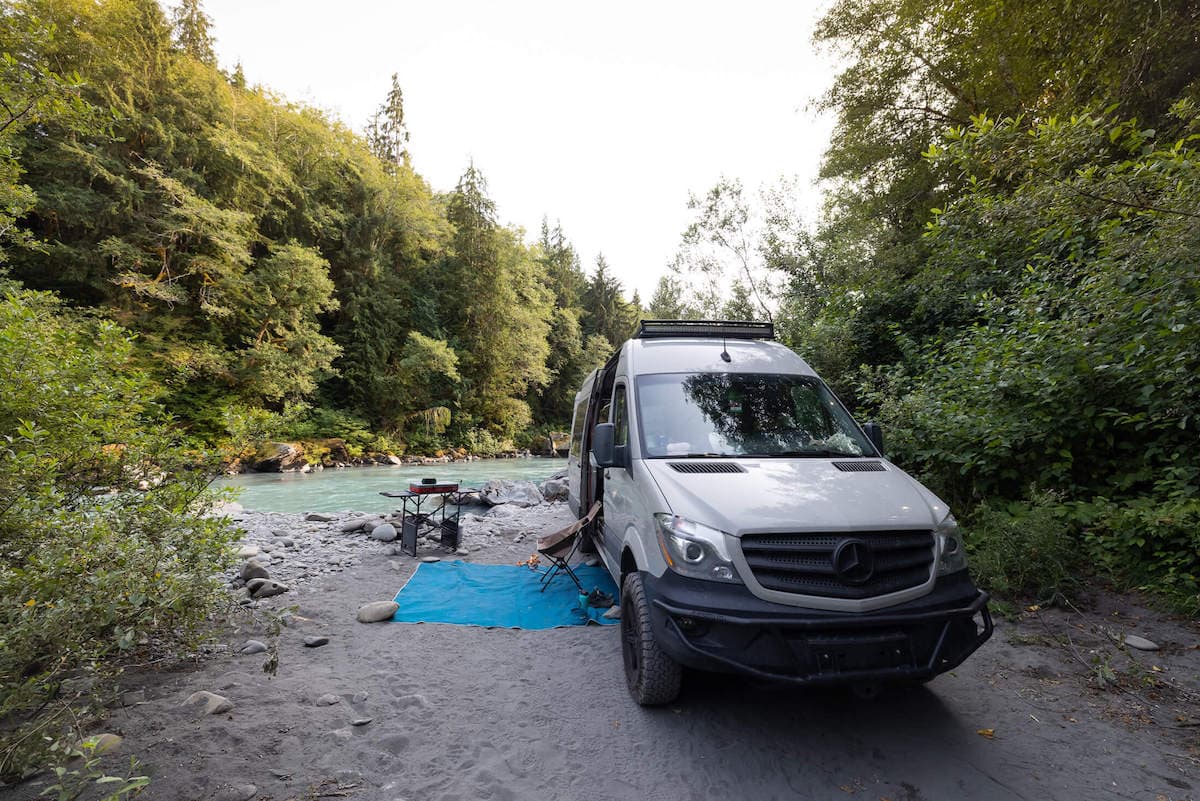
Over the last several years, there has been a huge increase in the size of the van life community, but with climate change on the forefront of many people’s minds, you may be wondering:
What impact does van life have on the environment? Where does sustainable van life come into play and how can we reduce our impact while traveling and living out of our vans? What are these “Leave No Trace” principles I keep hearing about from other van lifers?
This post may contain affiliate links.
What Impact Does Van Life Have on the Environment?
While the environmental impact of living on the road is generally much less than living in a house, there are still ramifications of van life:
Gas Emissions
According to the Environmental Protection Agency (EPA), the transportation sector contributes 27% of the total US greenhouse gas emissions, making it one of the largest contributors. This includes aircraft, trains, and ships, but vehicle transport alone is 83% of that total, and much of that is from regular commuter vehicles.
Considering the average American puts 13,000 – 15,000+ miles on their vehicle each year just as a regular commuter, it all adds up. Unfortunately, we haven’t derived an average like this for van travelers yet, but the range would be pretty wide if I were to guess. Depending on how and where you drive in your van, it is possible to cut this mileage total way down – we’ll get into that more down below.
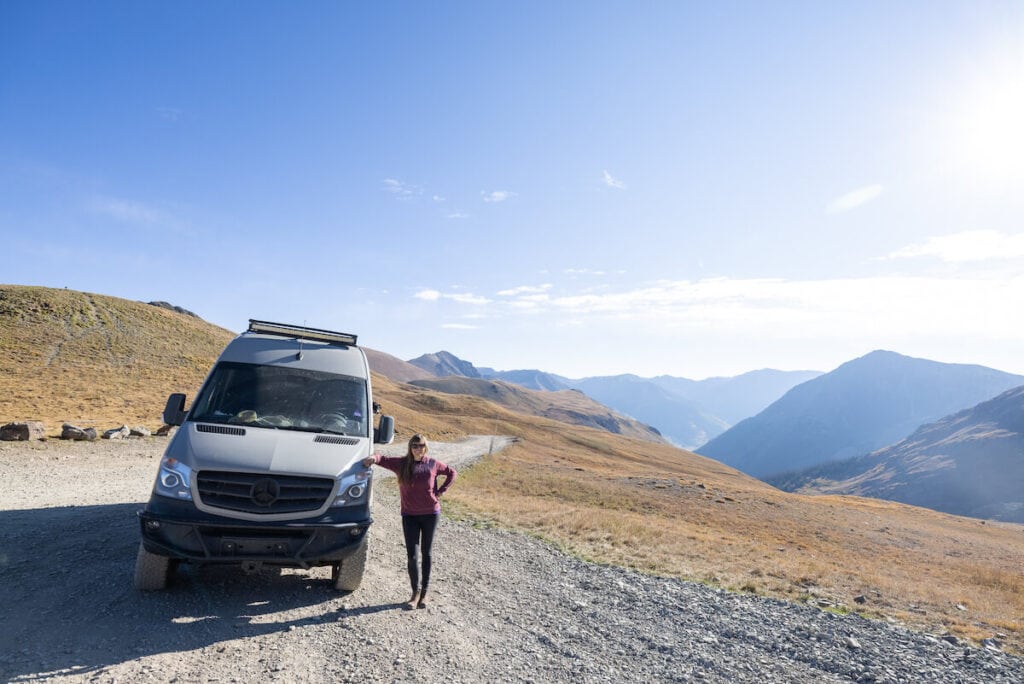
Impact On Outdoor Spaces
Another way the influx of van dwellers has on the environment is the number of people traveling through, camping on, and exploring outdoor spaces. With the rise in visitors, it’s even more important to do our part in protecting and preserving the areas we get to visit.
Over the years, I’ve seen littered trash, used toilet paper, trampled vegetation, and a disregard for restricted areas and outdoor ethics. When we are responsible outdoor explorers, our presence does not adversely impact the areas and, instead, could contribute to preserving the area for generations to come.
As van lifers, we always want to strive to leave places better than we found them. I believe education is at the foundation of being a responsible, respectful outdoor enthusiast and the first step in creating new habits is to become aware of our actions so we can learn to be better. Because, truthfully, a lot of people just don’t know how their actions impact the environment.
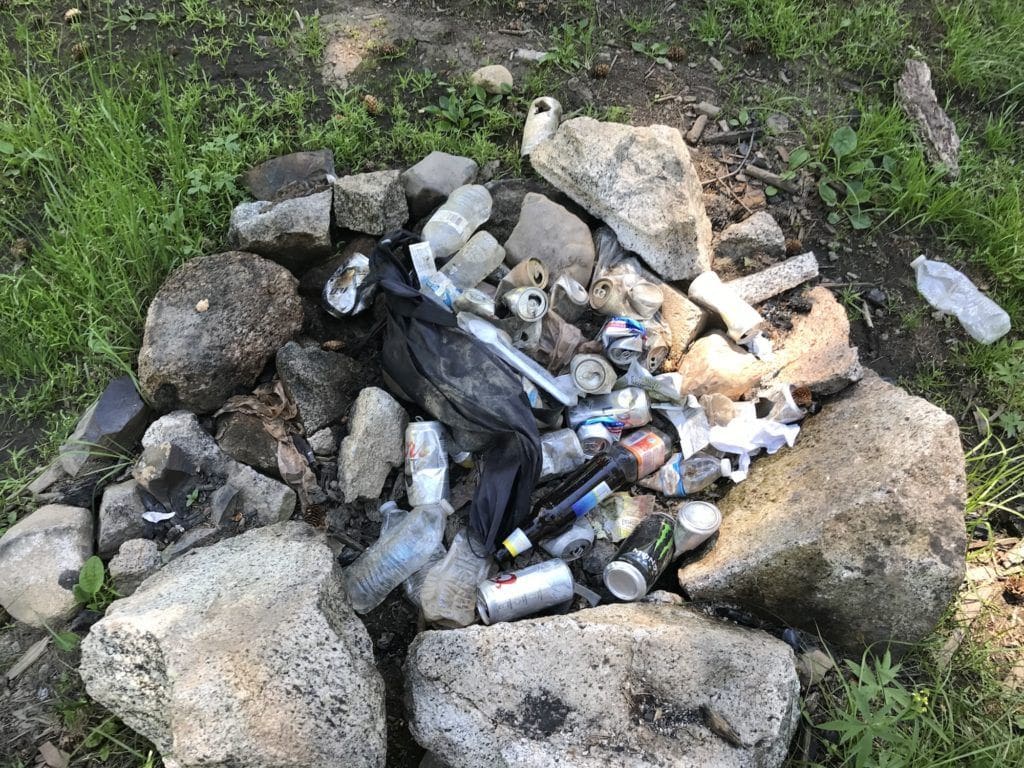
Save this post!
Enter your email & I'll send this post to your inbox! You'll also receive my weekly newsletter full of helpful advice for planning your adventures.
Tips For A More Sustainable Van Life
Use Eco-Friendly Materials
Whether you’re hiring a conversion company or DIYing your build, consider using salvaged or used materials as much as possible. The use of second-hand products reduces the demand for industries to produce more new products. It also keeps those previously-used items out of the landfill by repurposing them. A lot of older items have more charm too, so it might give your design a little extra character.
There are several places you can find used and salvaged materials, so don’t be afraid to get creative in your search:
- Local salvage yards and boatyards
- Construction companies
- Facebook Marketplace
- OfferUp
- Craigslist
- Thrift stores
- Habitat ReStore (great for pre-built cabinets and leftover flooring)
- Pawn shops (great for tools)
Travel Slowly
Driving less, moving slowly, and staying longer is one one the biggest ways to reduce your van life carbon footprint. There are tons of benefits of slow travel too, including less stress and more flexibility. Consider your van plans and try to map out the most efficient route. Instead of hopping campsites every few days, slow down and really enjoy where you’re at for a week or longer. Not only will produce fewer carbon emissions, but you’ll really get to enjoy the places you’re traveling to.
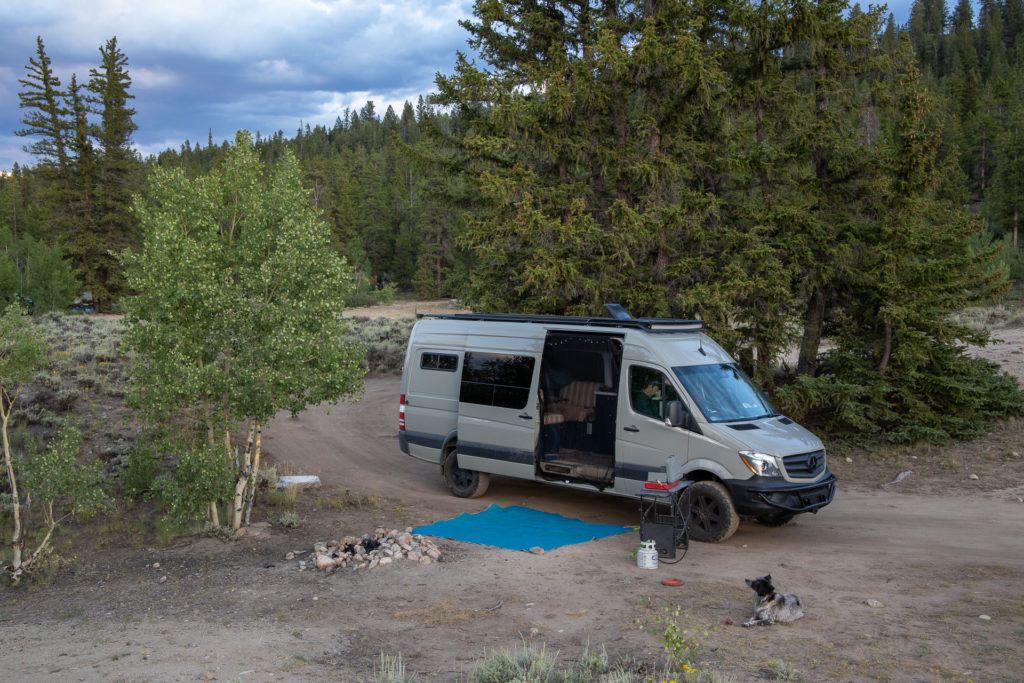
Drive Slower
It’s said that the most efficient speed to drive on the highway is 55-60mph. Once your speed increases from 65-75mph, efficiency decreases by 20%. Plus, the “drive less, move slowly, stay longer” guideline isn’t only better for the environment, it also means you get to relax and enjoy the view more than you could if you’re on the move frequently. You also save money on gas. I understand this might not be ideal for everyone’s circumstances and in all scenarios, but it’s a good practice to get into as much as possible in your journey to a more sustainable van life.
Be Water Conscious
In the US, the average person uses between 80-100 gallons of water per day for indoor home use (yep, per person, per day!) This includes toilet flushing, showers, dishwashing, cooking, and cleaning. That’s a lot of water! But, when you live in a van you don’t have the luxury of seemingly endless flowing water like you might at home. So, you’re forced to limit your water use to make the supply last longer.
Depending on your van’s plumbing and water systems, you might have a water tank anywhere between 7 gallons and 40 gallons; the majority of van lifers I’ve encountered have a water tank between 7 and 25 gallons (due to weight/space restrictions). Having such a limited amount of water available demands that you ration it for the duration of the trip. Since a water refill might not be readily available when you run out, this is one of the key van life essentials to living off the grid.
When we first moved into the van, it took a little figuring out before we got the system down. So, to help you save time (and water), here are some simple and effective ways to reduce your water consumption and conserve your supply:
- While doing dishes, place a bowl in the sink to catch the used dishwater. Then, reuse that water for all of your dishes. After they’ve been scrubbed, just give them a quick light rinse.
- Save any and all unused water – keep an empty jar around in case you pour more water than you need and save it for later use.
- Do not run the faucet full-blast. Start with the least amount of flow possible, then increase if you need more water or pressure.
- Turn off the water in between uses (soaping up your hands, scrubbing dishes, etc.) Only run the water when necessary.
Reduce Your Trash
Minimizing the waste you produce is one of the primary ways to enjoy a more sustainable van life. In most cities and larger towns, trash and recycling get picked up by the city once or twice a week. Between that time, we fill our trash bins with garbage, food, packaging, etc., and then it magically disappears. While this is convenient, we might not realize how much trash we’re creating. And if we don’t know, then how can we start reducing it?
>> Read Next: How To Reduce Your Waste While Camping
Similar to the water topic above, waste production becomes apparent pretty much instantly when you move into the van. Your space is small; you’re moving frequently; there’s no magical garbage fairy to remove your trash – it all piles up until you deal with it. You’re the one handling your trash and separating the recyclables, compost, and landfill items. You’re the one storing the trash when you’re off-the-grid away from facilities. So, how do we reduce our waste as an eco-friendly van lifer? Here are some tips:
- Buy fewer packaged items (for example, choose produce that isn’t wrapped in plastic)
- Shop from bulk bins and bring your own reusable bulk bin bags
- Say no to disposable bags while shopping – use reusable bags and produce bags instead
- Invest in high-quality reusable products for storage, like mason jars, or re-use glass jars (pasta sauce and pickle jars are perfect)
- Use reusable storage products like Stasher bags and beeswax wrap instead of Ziploc bags and plastic wrap
- Eliminate single-use disposable items, like plasticware, disposable utensils, and beverage cups
- Use cloth materials instead of paper towels – you can even cut up old sheets to make a bunch of cloth napkins
- Get a refillable propane tank instead of using the disposable 1lb green canisters
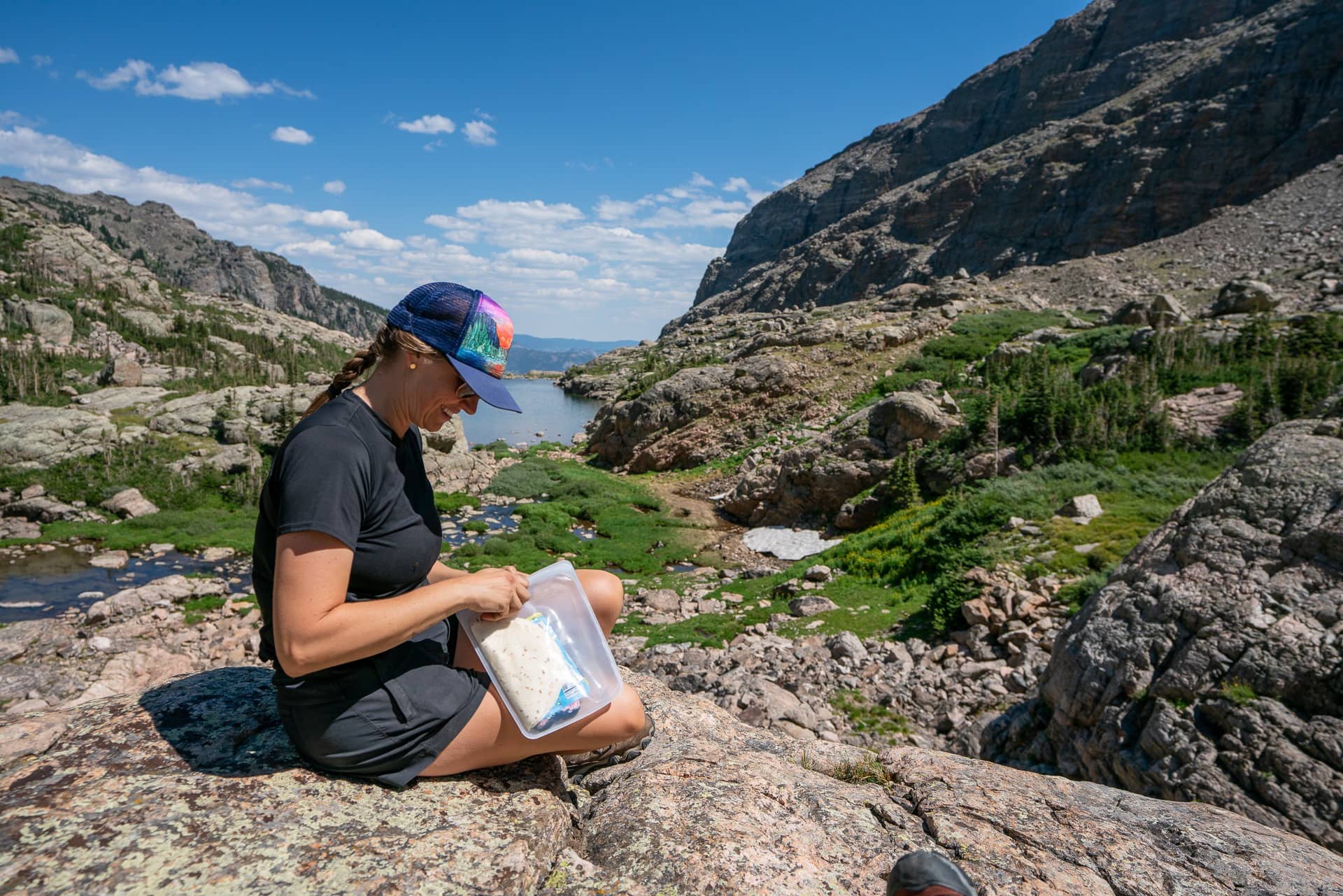
Buy Less Stuff
Buy less, acquire less. There isn’t enough room in a van to accumulate unnecessary items, which makes this van life sustainability tip a relatively easy one to follow.
You won’t have a surplus of storage space when you’re living tiny, so you’ll be forced into admiring things that you encounter without taking them home with you. Whether or not you realized it before, you’ll be participating in a practice of non-attachment because you, quite simply, don’t have room for the stuff you don’t need.
So, make your purchases count by investing in products that will last and buying used items whenever possible. This will create less waste in your van and the environment.
Stop and Reflect
Being environmentally conscious provides continuous learning opportunities. Ultimately, if we have the privilege and opportunity to explore beautiful places in a van, we have a responsibility for something greater. We have the responsibility to reflect on our actions and how we might be impacting the land and the people around us. As you travel, you’ll undoubtedly encounter moments where you spot a gorgeous view that would make the perfect Instagram photo if you parked there, but you can tell no one has camped there, and it probably isn’t a good place for anyone to camp anyway… BUT… it would just be the perfect spot and the perfect photo!
So, what do you do?
We’ve all had moments like these, whether it’s out hiking on a trail and you see another switchback ahead of you and you contemplate cutting the switchback, or it’s in a situation like I just described above. I encourage you to just pause. Take a moment and reflect on why you’re out there doing what you’re doing. What inspired you to hit the road? What inspired you to live in a van? Maybe it was an awesome photo online, but what is the deeper motivation that drove you to get out there? And, then remind yourself and your friends that our individual actions make a significant impact on the environment around us. In those moments, consider these important questions:
- Are my actions benefitting the land and its resources for future generations?
- Is there anything I can do that will prevent further damage?
- Do I want this land to flourish?
- Do I want others to enjoy these places as I am?
Leave No Trace Principles for Sustainable Van Life
The seven Leave No Trace principles are important to follow anytime you’re recreating outdoors, but here’s here they relate specifically to van life:
1. Plan Ahead & Prepare
Part of the fun about van life is the ability to be spontaneous, so what exactly does this mean for van lifers? It means to familiarize yourself with the area you’ll be traveling through. Learn about the land, who regulates it, if there are current travel restrictions, and if there are any sensitive environments you should be aware of.
You’ll want to find out:
- What are the local regulations?
- Are there any current travel restrictions?
- How long are you allowed to camp?
- Are there fire restrictions?
- Are there bathroom and trash facilities or do you need to have a plan for waste disposal?
- What wildlife lives there? Do I need to be mindful of how I cook or store my food?
The easiest way to find answers to these questions is to stop at the local ranger station or visitors center, or the kiosk that you’ll often find at the entrance to dispersed camping areas. If these aren’t around, look up the regulations online, and be sure to stop and take the time to read any signs that you see.
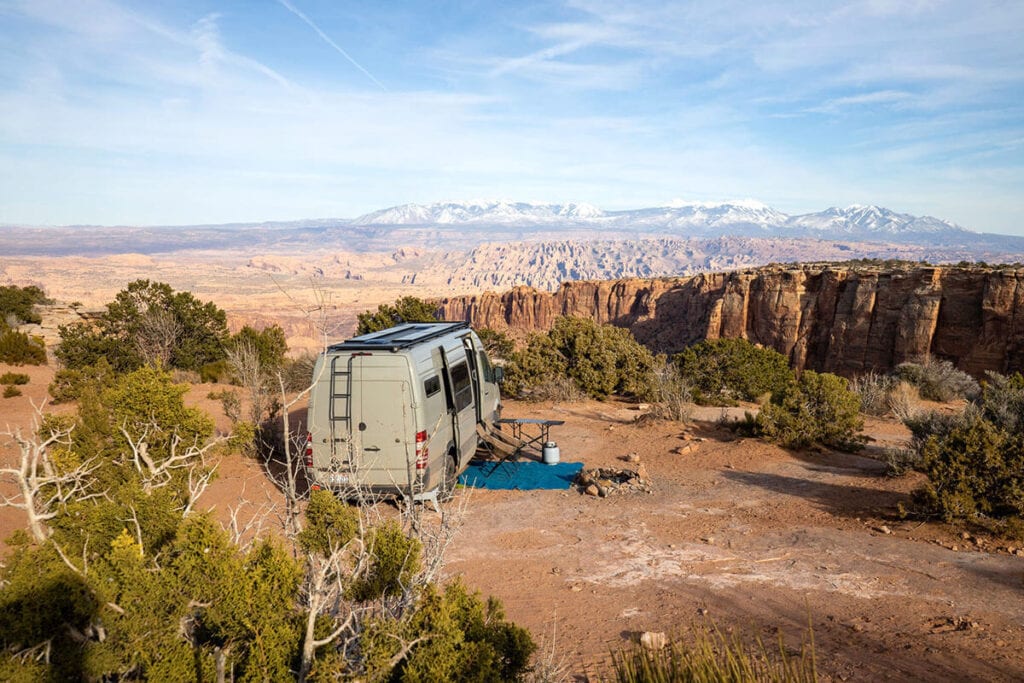
2. Travel & Camp on Durable Surfaces
Irreparable damage occurs when cars or people cross over soils and vegetation which contain entire communities of microorganisms. Land management agencies do their best to provide trails, roadways, and designated camping areas so that we’re able to enjoy these special environments without causing further damage.
Highly durable surfaces like rock, sand, dirt, gravel, and pavement are the best places to park your van. Avoid parking your van near fragile surfaces that you’ll trample on as you walk around camp.
You also want to be 200 feet from water sources. This is to prevent your grey water from running off into freshwater sources, as well as to give you a healthy buffer when going to the bathroom (responsibly) outside at your camp.
Responsibly deciding where to park for the night is based on the allowed uses for the land, the sensitivity of the soil and vegetation, the potential to disturb wildlife, and an honest assessment of the impact you and your group might have on the area. As van lifers, we always want to strive to leave places better than we found them.

3. Dispose of Waste Properly
Otherwise known as pack it in, pack it out, this applies to all outdoor activities whether you’re camping, hiking, or van living. Whatever comes with you, needs to leave with you. The goal here is to leave the area as good as or better than you found it.
Pack out all of your food scraps, including banana peels, apple cores, and pistachio shells. Even though these will biodegrade eventually, this can take a long time and it adversely impacts the next person’s experience and also habituates wildlife to eating human food.
When it comes to peeing outside, this doesn’t adversely affect the vegetation but the salt content can attract some animals. For this reason, pee on rocks, pine needles, and gravel whenever possible, as opposed to living plants. Anytime you use toilet paper, be sure to pack it out. Another handy option is the Kula Cloth, an antimicrobial pee cloth.
Learning how to properly dispose of human solid waste, or #2 as you might call it, is super important to prevent pollution of the land and waterways. Plus, no one likes to stumble on someone else’s poop or used toilet paper when they’re taking a morning walk through camp. I can’t tell you how many campsites or trails I’ve been to where I’ve found used toilet paper littered about or left behind a bush where someone relieved themselves and frankly, it’s pretty gross. We as van lifers who live on public land need to do better.
If there’s a bathroom facility, use it. If you have your own toilet in your van, use it. Otherwise, go at least 200 feet away from any water sources, trails, and camp and dig a cathole that is 6-8 inches deep. You’ll want to carry a small shovel or trowel with you in your van if you don’t have your own bathroom to make digging a hole easy.
Ideally, fertile rich soil is the best so the bacteria can break down the waste. Do your business, cover with soil, and pack out your used toilet paper. With your van right there, it’s as simple as tossing your used toilet paper in your garbage can, followed by washing your hands. No big deal.
Most of the time, burying your human waste in a 6-8” deep cathole will adequately meet LNT criteria, but it’s a good idea to familiarize yourself with the regulations of the place you’re in. Some areas in sensitive habitats have specific protocols that might ask you to pack out your human waste too. If this is the case, you’ll want to make sure you travel with a toilet (even something as simple as this go-anywhere portable toilet seat) or carry a few wag bags to make packing out your waste easy.
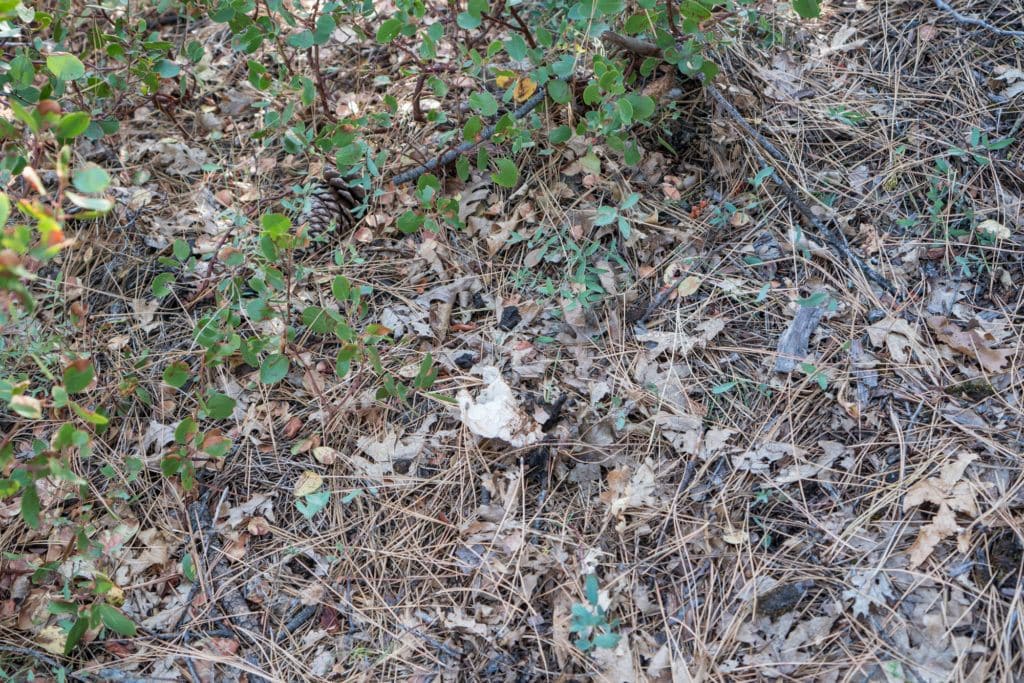
4. Leave What You Find
This one is pretty simple. Admire and appreciate the things you see but leave them how you find them unless it’s trash. Then pack it out.
Otherwise, take a photo if you’d like to remember it, but then carry on. It’s actually easier to do this once you’re living in the van because space is so limited so you don’t have much room for all the cool rocks or shells you might find.
5. Minimize Campfire Impacts
Minimizing your campfire impacts is especially important for living a sustainable van life. You’ll probably find that you don’t have campfires nearly as often as you might when you are tent camping, but it’s still a nice thing to do once in a while.
If there’s a designated fire pit or fire ring, use it as long as there isn’t a fire ban in effect. Keep the fire small and gather wood from already dead and downed trees or bring your own locally purchased firewood. Be mindful of the wind and always drench the fire before you go to bed.
If you find trash in the firepit, it’s also nice to remove it so the next camper will arrive at a clean spot. If there isn’t a fire pit, then don’t build a new one and skip the fire that evening. Fires scar the ground, and we don’t want to be leaving new marks at the campsites we stay at.
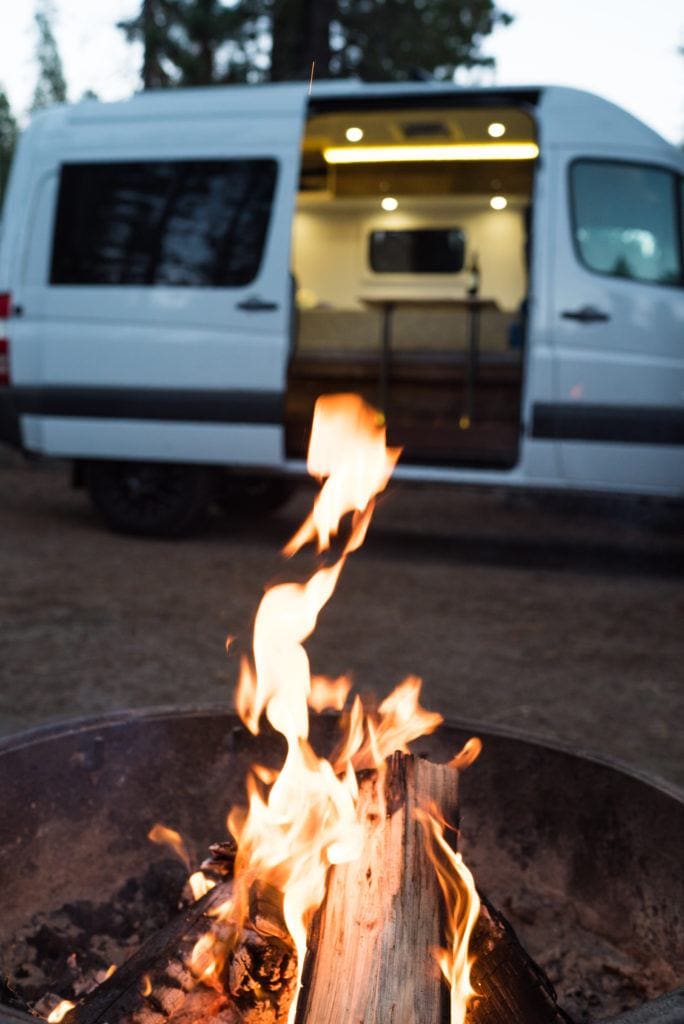
6. Respect Wildlife
One of the exciting parts of camping and traveling to wild places in your van is the potential to encounter wildlife in their natural habitat. If you do, remain quiet and give them a lot of space to carry on their way while you observe from afar.
Properly storing your food, trash, and scented products will help to keep animals safe and away from your camp, as well as parking more than 200 feet away from a water source.
We’ve talked about the benefits of doing this for pollution reasons, but it’s also good practice so that animals feel like they have plenty of space to access their water source. If you’ve got pets as copilots, keep them nearby and make sure they don’t interact with or bother the locals. Check out this post for more tips on wildlife safety.
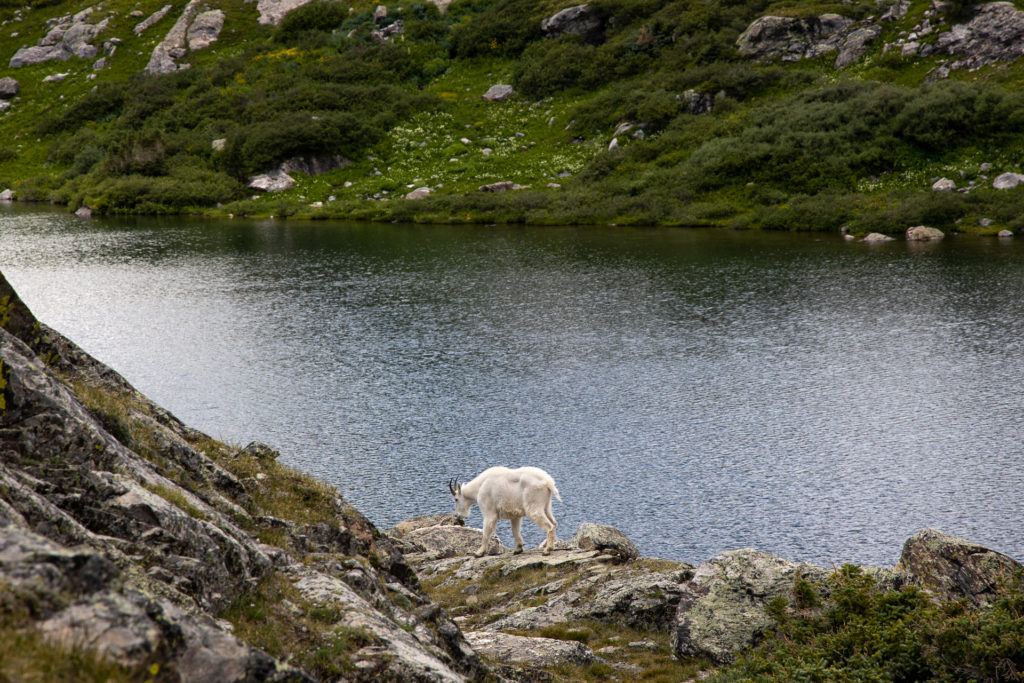
7. Be Considerate of Other Visitors
As more people are doing van life and calling public lands their home, it’s critical that we are mindful of our impact and treat nearby campers with respect.
We might come from different places and have different camping styles, vehicles, and interests but at the end of the day, we’re all out there to enjoy ourselves and enjoy nature. A lot of people like solitude, so whenever possible, offer enough space to neighboring campers so that everyone can enjoy themselves outdoors.
If you follow me online, you know I love good music, and I’m sure you do too! But, your neighbors might not love the same music you do. Sound travels far, so be considerate of when and how loud your music is playing to make sure your neighbors can’t hear it, especially once the sun goes down.
As I said, everyone does things differently but a little consideration goes a long way when you’re outdoors. My rule of thumb is that you having a good time outside shouldn’t affect my ability to have a good time, within good reason of course. It’s a friendly practice to consider how your actions might be impacting another’s experience.
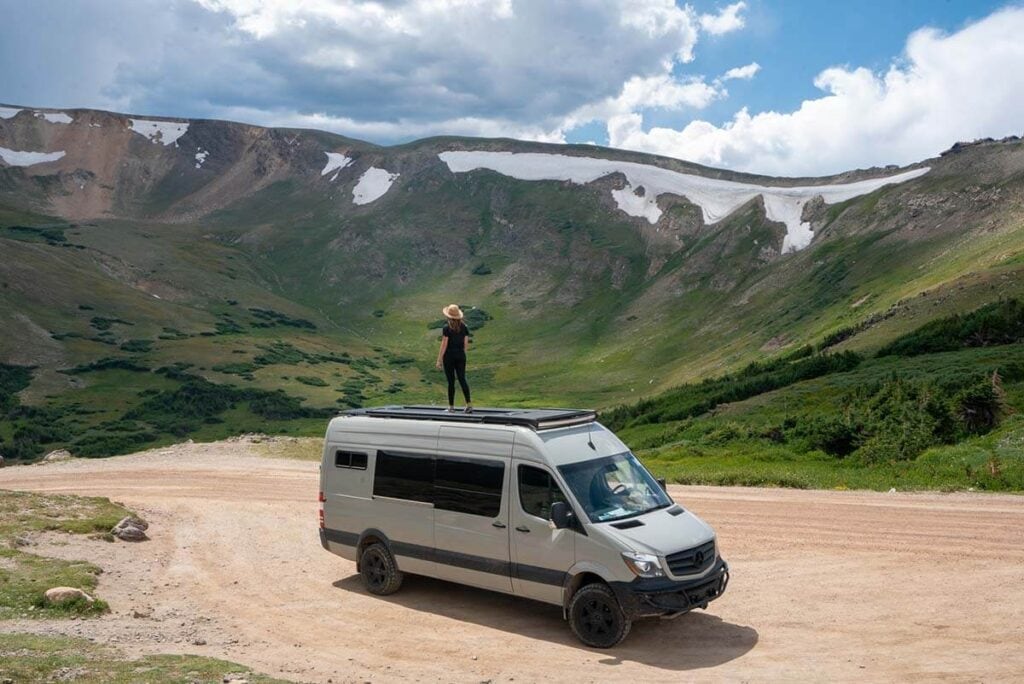
Why Is Leave No Trace Important for Van Life?
As you head out in your van, you’ll have many opportunities to explore wild and beautiful places. Whether you’re already an avid outdoors person or are interested in exploring more outdoors, understanding these essential LNT principles is a must in order to keep van life sustainable. The purpose of LNT is to provide guidelines that help us make responsible choices when we engage in outdoor activities to ensure future generations have the same opportunities.
When people don’t respect the land by leaving trash and toilet paper behind, for example, the public agencies that manage the land often end up implementing tighter restrictions and user fees to help compensate for damage. The LNT principles that I cover in this post will help preserve the land while also making sure it remains open and available for all of us to enjoy responsibly.

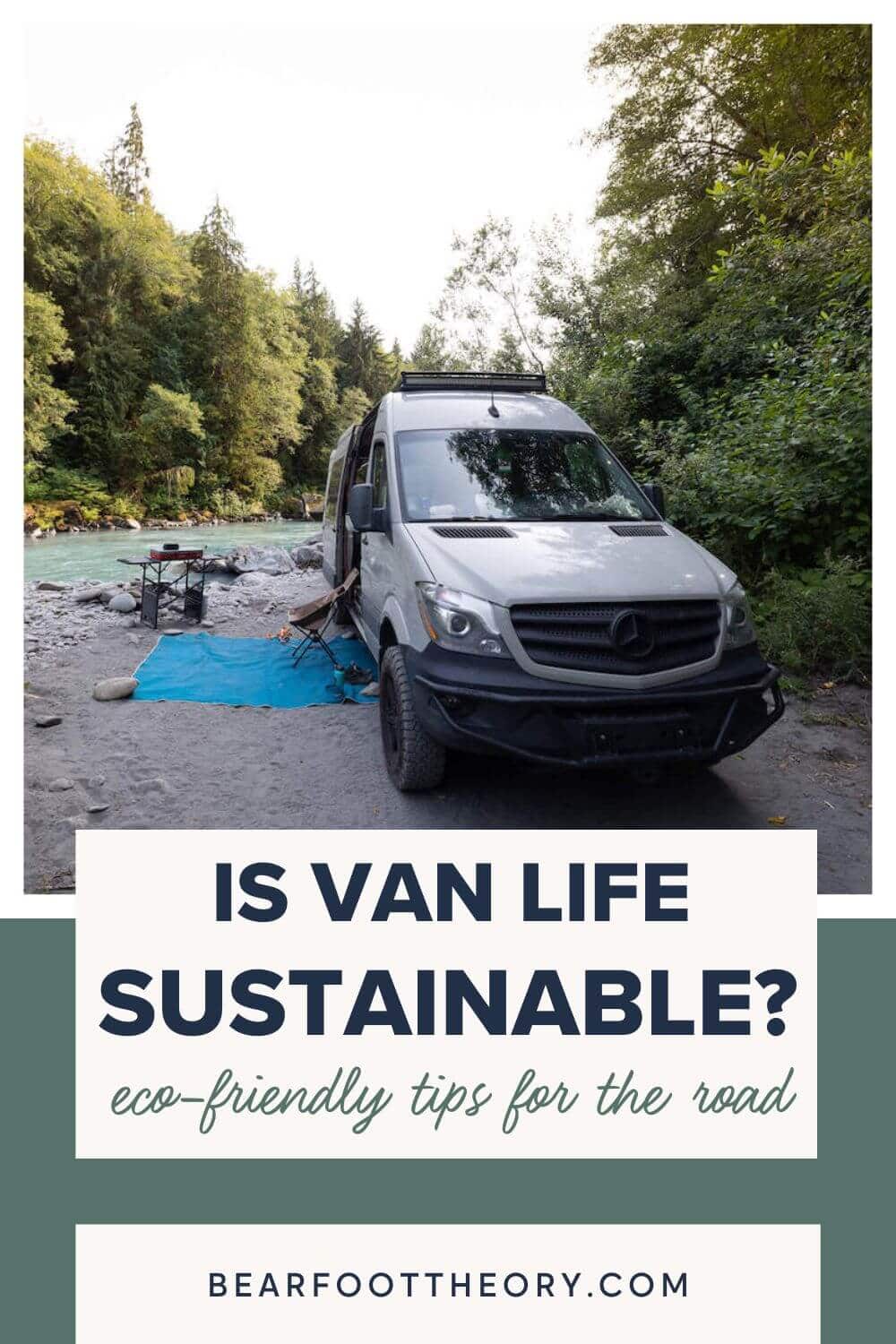
Thanks for sharing this awesome piece of information. Loved the post
This pos t is awesome. I have been trying to set my life as a minimalist. I’ve reduce my waste as well. It is pretty easy when you are at home. But in van? Well, I do not know… It was kinda hard 🙂 I’ve built a camper before Covid-19 started in Europe. I had limited time to travel because of corona but sustainability was hard for me. Because I was not alone, I was traveling with my friend and he was buying and wasting everything. Anyway, my point is, reading this artcile really helps! Thanks. 🙂
Glad you found it helpful Melke! All the best 🙂
The above is a reat article for pointing out basics people might not think about. I was so ignorant, mu first night camping I made a little campfire in a large pot, and then was amazed the next morning to discover that the heat from the bottom of that pot had buned a big black circle in the lush green grass we’d camped in. It looked terrible and so irresponsible. I was quite embarrassed. People like me just don’t know until we experience such mistakes. Your wisdom above should help others a lot.
As for disposable grocery bags they can be used as trash bags. Or you can be really weird like me and use reusable grocery bags but raid the bin for plastic bags returned for recycling.